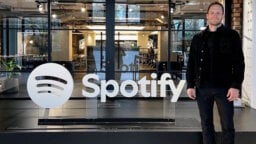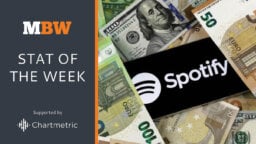You’d be a fool if you didn’t notice that, as streaming continues to cannibalize the ‘old world’ music business, there are some growing tensions out there.
The labels are arguing with Spotify over the amount of money they should be paying.
The labels are also arguing with YouTube over the amount they should be paying – but this time, Spotify’s backing them up.
Meanwhile, the publishers are arguing with the labels over the share of cash they’re not getting paid – especially from Spotify and YouTube.
As for the managers, songwriters and artists? They getting paid last of all – while watching the labels post record annual revenues.
Universal Music Group says there is a solution to this tricky Mexican stand-off.
It goes a little like this: you’re all going to have to trust us, and we’re going to have to trust all of you…
This outward call for harmony arrived this week from Jonathan Dworkin – UMG’s SVP of Digital Strategy and Business Development – and it had a serious message at its heart.
Speaking at Music Ally and the Music Business Association’s NY:LON Connect conference in London yesterday (Jan 24), Dworkin suggested that, if the industry in-fighting currently bubbling away doesn’t simmer down, the music business might miss the opportunity to maximize its digital future.
“If we’re going to continue to meet the challenges of technological change, we’re going to need to develop a deeper culture of trust – between artists and labels and publishers and managers and digital services and entrepreneurs,” said Dworkin in his opening keynote address, which you can listen to below.
“we’re going to need to develop a deeper culture of trust – between artists and labels and publishers and managers and digital services and entrepreneurs.”
Jonathan Dworkin, UMG
He added: “I truly don’t think were any longer an industry which looks to hold back innovation.
“In the days when the waves were breaking on our heads, we may have been filled with fear, but I can tell you that for me and my colleagues at Universal, we very much want to lean into the future and enable truly amazing experiences around music.
“That’s not to say, however, that we can or will shirk our responsibility to resist the commoditization of music.”
Ah, yes: Dworkin’s speech also touched on that most sensitive of industry topics – the division between free and paid streaming tiers.
This is an especially prescient topic right now.
Spotify is attempting to bring down the share of revenue it pays labels from 55% to 52% – while the labels want it to further limit the offering of its ad-funded tier.
Meanwhile, YouTube is under continual pressure to pay more to songwriters and artists, with more than 186 big-name acts (such as Taylor Swift and Paul McCartney) recently petitioning against its legal protection to do so.
“we don’t know how far paid streaming can go. But we do know that growth will be stalled if it doesn’t provide adequate value beyond that of free alternatives.”
Jonathan Dworkin, UMG
“Just to reiterate [Universal’s] longstanding position: we support both of these models and their appropriate role in the music ecosystem,” said Dworkin of paid and ‘free’ streaming – going on to praise ad-funded products for being “quoted as the No.1 reason people stop pirating music”.
“But fundamentally, if music’s to achieve its full growth potential, it will need to most effectively drive the value that consumers ascribe to music – and monetize the consumption of the enormous audiences today attracted to free services,” he continued.
“The truth is, as these swells continue to propagate we don’t know how far paid streaming can go. But we do know that growth will be stalled if it doesn’t provide adequate value beyond that of free alternatives.”

Dworkin added: “While in a nascent market there’s been a strong argument from consumer services that features, not content, differentiate free from paid, consumers are demonstrating with accelerating force that they’re willing to pay for high-quality premium content.
“Whether it’s Netflix‘s transition to original content or the phenomenal growth of Amazon Prime’s video offering, consumers are voting that great content is worth paying for.
“It would be naive to think every person on the face of the planet will pay for music or music-based content.
“But in the absence of significant improvement in monetization, we must further bolster premium propositions with the world’s most desired content.
“In India, for example, you’d have to watch user-generated videos for more than a month straight without sleep to earn $1 for rights-holders. That’s a lot of squirrels on water-skis.”
Jonathan Dworkin, UMG
“We at Universal continue to support our partners in the ad-funded content world. It serves as a foil to piracy, a solution for consumers less willing to pay for music and as a ramp to paid services.
“But we need to enlist the help of these services in securing our content in their ecosystems so that we can choose how our music is made available to consumers and at what rates.
“In India, for example, you’d have to watch user-generated videos for more than a month straight without sleep to earn $1 for rights-holders. That’s a lot of squirrels on water-skis.
“Today the economics simply don’t add up, but if we’re able to meaningfully differentiate the content proposition between free and paid, and help find a way to transition traditional media dollars to digital, we have the opportunity to tap into another significant well of growth over the coming years.”
Food for thought.
Listen to Dworkin’s speech below, or read an abridged version of the full thing – helpfully provided by your friends at MBW…

In 1997 I couldn’t wait to join the limitless growth of the business; I was looking forward to riding round in the back of an Escalade, throwing televisions out of windows and running big, complex hustles. I had no idea I’d be a matriculating member of the freshman class of the apocalypse.
I’ve always loved the convenience that technology brings to our lives, but to be really honest I’ve never really been a technologist. What I really care about is music.
“Suffice to say we were caught at the edges of some tectonic trends – not only changing the music business, but changing the world.“
I started as an intern and subsequently as an assistant engineer at Unique Studios in New York; notable for, among other things, being the place where Biggie – the indisputable greatest rapper of all time – recorded Juicy.
I’m gonna refrain of telling the story of what’s happened to the music business between then and now; the decimation of my thick mane of hair tells that story all on its own.
Suffice to say we were caught at the edges of some tectonic trends – not only changing the music business, but changing the world.
As access to higher speed data proliferated, so did piracy. And the competition for consumer attention became all the more fierce.
I’m sure there are things that the industry could have done differently to adjust to the change more ably. But the industry was no more responsible for the fundamental dynamics that changed the business than we are for the fragile and exciting recovery we’re experiencing today.
It really does feel like we’re a boat adrift on an ocean of technological change.
“In 1998, when Napster launch, we were pounded by the waves of innovation which exposed what had become an inflexible business.”
In 1998, when Napster launch, we were pounded by the waves of innovation which exposed what had become an inflexible business – a finished goods wholesaler – to the merciless ubiquity of supply that the internet brought.
Now, it seems we’ve moved from being pummeled by the waves of technology to capturing their energy to catalyze our business – and to move more and more people with music than ever before.
But before we all go home and claim credit for having saved the music business, it’s instructive to talk about the forces that drive these tides.
There are about 7bn people in the world, and there about 8bn mobile connections. More than a billion of those run across high-speed 4G networks, [who] represent about 5bn unique mobile subscribers. In 1997, for context, there were about 70m people with internet access. And in 2001 when the first iPod was released, there was only about 500m people globally.
Mobile data traffic continues its growth on an exponential trajectory having grown 4000X over the last ten years alone.
“In 1997, for context, there were about 70m people with internet access. And in 2001 when the first iPod was released, there was only about 500m people globally.“
The access to cheap, fast, ubiquitous data and pristine devices helps drive consumer demand for high quality music and music services.
The broad adoption of cloud-based consumer services may have been the most impactful development to drive our industry shift.
Seamless integration between platforms, devices and locations has become the baseline of consumer expectation.
The good news is, with the phenomenal proliferation of cheap and abundant data, we somehow managed not to create a world of pirates.
Sure, there’s piracy – and while piracy has plateaued, it’s plateaued at fairly high levels: stream-ripping, file-sharing and torrents still represent very real threats.
But consumers are choosing, with increasing velocity, high-quality, portable services with the full complement of the world’s music.
It feels like, at last, thanks to significant investment by the music community, the work of some incredible partners and salubrious macro-technological trends, the industry’s offerings now are superior to piracy – and consumers are reacting.
“Speakers and music go together like guns and drugs.”
And there’s yet another swell driving us along: the renewed platform war in the living room. Google Home, Amazon Echo and others are competing for our attention through voice interactivity, taking the very welcome form of a speaker.
Speakers and music go together like guns and drugs.
And when you think about the convenience afforded to consumers when you combine high-quality services with voice interactivity in an output device, it’s yet another swell that will help connect artists with fans, drive the growth of our business and help migrate consumers to legal services.
While these trends are consistently transformative, they propagate at vastly different rates. This unevenness creates a whole new complexity and belies whole new opportunities.
Said another way, the world is lumpy.
We have markets like the Nordics, with 20% penetration of paid streaming, growing from the ashes of markets that were ripe for transition: decimated by piracy, home to relatively wealthy populations and culturally ready to embrace the new model.
We have markets on the very early side of the transition, like Japan and Germany, where the shift is more measured, the physical business remains resilient and consumers haven’t yet fully grasped the value proposition that streaming offers.
And of course there’s the enormous opportunity of markets that sit between the poles – showing the promise of streaming beginning to capture the imagination of consumers, but still leaving some of the world’s leading music markets with plenty of room for growth.
Of the 3bn smartphone subscriptions which Ericsson’s Mobility Report predicts will be added to by 2021, 56% of them are going to come from APAC, and 24% from EMEA.
Consumers in these markets will adopt mature digital music services synchronously with the growth of the consumer technology to support them.
“In the next ten years, China may very well become the world’s largest recorded music market.”
China, currently the world’ 10th largest music market, will be transformed into one of the world’s leading markets, driven by innovative platforms like Tencent, Alibaba and Baidu, together with global platforms and strong support from the Chinese government.
In the next ten years, China may very well become the world’s largest recorded music market.
And with the limited development of domestic repertoire today, that could drive a creative movement in the Chinese music business that rivals the ’60s and ’70s in the West.
So we should breathe deeply this new oxygen, and celebrate the course we’re set upon – but all of this is not to say we’re assured smooth sailing, by any measure.
These technological swells have driven growth in an emergent, transformed music business. That being said, the recovery is fragile.
Two of the industry’s top five accounts are operating with negative margins, funded by other people’s money.
A financial shock that would impact investor confidence could easily threaten the turnaround we’re beginning to experience.
As such, we need to find ways to ensure we have a balanced ecosystem of partners – platforms and pureplays – who can drive consumer delight, build intuitive and innovative products and help ensure that our artist’s music reaches the right fan at the right time.

I’d be remiss – and I wouldn’t be a proper record guy – if I didn’t talk about how these shifting tides square up in the discussion of free and paid.
Just to reiterate our longstanding position: we support both of these models and their appropriate role in the music ecosystem.
“Just to reiterate our longstanding position: we support both of these models and their appropriate role in the music ecosystem.”
In 2016 in the US, digital ad spend overtook television advertising for the first time.
And while digital radio listening is on the rapid rise, 91% of Americans aged 12 and older still listen to terrestrial radio.
Suffice to say, like many things in the digital realm, the change will take longer than anticipate and the impact will be further reaching than ever imagined.
Additionally, availability of free licensed alternatives is quoted as the No.1 reason people stop pirating music.
But fundamentally, if music’s to achieve its full growth potential, it will need to most effectively drive the value that consumers ascribe to music – and monetize the consumption of the enormous audiences today attracted to free services.
The truth is, as these swells continue to propagate we don’t know how far paid streaming can go. But we do know that growth will be stalled if it doesn’t provide adequate value beyond that of free alternatives.

While in a nascent market there’s been a strong argument from consumer services that features, not content, differentiate free from paid, consumers are demonstrating with accelerating force that they’re willing to pay for high-quality premium content.
Whether it’s Netflix’s transition to original content or the phenomenal growth of Amazon Prime’s video offering, consumers are voting that great content is worth paying for.
It would be naive to think every person on the face of the planet will pay for music or music-based content.
But in absence of significant improvement in monetization, we must further bolster premium propositions with the world’s most desired content.
“We at Universal continue to support our partners in the ad-funded content world. It serves as a foil to piracy, a solution for consumers less willing to pay for music and as a ramp to paid services.”
We at Universal continue to support our partners in the ad-funded content world. It serves as a foil to piracy, a solution for consumers less willing to pay for music and as a ramp to paid services.
But we need to enlist the help of these services in securing our content in their ecosystems so that we can choose how our music is made available to consumers and at what rates.
In India, for example, you’d have to watch user-generated videos for more than a month straight without sleep to earn $1 for rights-holders. That’s a lot of squirrels on water-skis.
Today the economics simply don’t add up, but if we’re able to meaningfully differentiate the content proposition between free and paid, and help find a way to transition traditional media dollars to digital, we have the opportunity to tap into another significant well of growth over the coming years.
Technology is the great simplifier; it can take a bespoke task and make it highly scalable.
There are 20,000 tracks uploaded onto streaming services every day and 300 hours of video uploaded to YouTube every minute.
The democratization of content creation and distribution is an important, incredible, exciting development in our digital age.
Curation by digital services, whether human or algorithmic, may hold the promise to mining the gems from this enormous glut of content, and surfacing them to the user. It’s a bold promise, and a promise I worry may be dangerously imperfect.

Identifying and developing talent, investing, driving passion, exposure and impression around the artist’s works globally is a long chain of engagement in curation and development.
It’s critically important to moving art and culture.
I guess what I’m saying is this: I’ve come to realize that the explosion of streaming has created a new kind of risk; the risk that fundamentally changes the audience’s experience of music and threatens to transform an ecstatic event into the same kind of distraction that drives us to fill up every spare moment with noise – literally.
“I really fear that we may draw a false correlation where we rely too heavily on data to tell us what is good art.”
The same behavior that drives us to fill every blank space with a check of our email, stock prices, sports scores and headlines.
We must be an industry of people dedicated to making great music, not just music least likely to be skipped.
I really fear that we may draw a false correlation where we rely too heavily on data to tell us what is good art. And the partnership between labels – who discover and nurture the music that not only sates us but surprises, challenges and delights us – and the services that productize it, is delicate and critical.
We need to continue to work together like the two dolphins on my Yin-Yang tattoo.
We as labels have an obligation to continually reinvent ourselves.
I’m genuinely proud to say that the teams at Universal put enormous energy and intellectual integrity into [this] transformation.
Not only do we need to discover, nurture and invest in talent, but we also need to constantly move ourselves closer to consumers.
Shifting technological tides often caused the re-imagination of the value chain – and labels need to build, modernize and reformulate our services to meet the rising waters.
It can be easy to rely solely on digital services to aggregate consumers so we can put our releases in front of them.
But we need to energetically create deep, wide, direct engagement between our artists and their audience. We remain at the very beginning of this journey – with new tools and new challenges.
We must continue to innovate our product; engaging the future of current technology and moving beyond to the emergent wings of innovation.
“Our product must evolve to meet the needs of the next business – and the future demands of our consumers.”
Video today drives more than 55% of global mobile internet traffic.
Our product must evolve to meet the needs of the next business – and the future demands of our consumers.
Whether further extending our investment in audio/visual content like Amy and The Beatles: Eight Days A Week; taking a leadership role in virtual and augmented reality; driving the proliferation of high-resolution streaming formats – we must expertly pilot the technological swells that will drive the next wave of content innovation or risk being pummeled by change once again.
I also believe that if we’re going to continue to meet the challenges of technological change, we’re going to need to develop a deeper culture of trust – between artists and labels and publishers and managers and digital services and entrepreneurs.
I truly don’t think were any longer an industry which looks to hold back innovation.
In the days when the waves were breaking on our heads, we may have been filled with fear, but I can tell you that for me and my colleagues at Universal, we very much want to lean into the future and enable truly amazing experiences around music.
That’s not to say, however, that we can or will shirk our responsibility to resist the commoditization of music.
“we cannot and will not shirk our responsibility to resist the commoditization of music.”
We must rabidly defend the value of our artists’ creations – but that does very much mean that we need to encourage and elicit a new culture of trust, so that we can share the risk and reward of riding these waves.
So, here we are. Salubrious winds in our sails.
Enjoy the moment we’re experiencing; the same way you would enjoy flat seas and blue skies and the feeling that we’re singularly consonant.
But know also that without preparation, agility and intellectual integrity, we will be ill-suited to meet the next wave of change and innovation that will most certainly come.Music Business Worldwide




